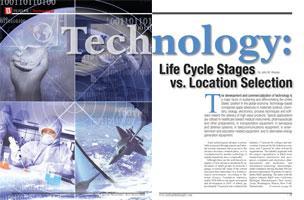

Technology’s Development
The development and commercialization of technology is a major factor in sustaining and differentiating the United States’ position in the global economy. Technology-based companies apply advances in materials science, chemistry, biology, electronics, process techniques and software toward the delivery of high value products. Typical applications are utilized in healthcare toward medical instruments, pharmaceuticals and other preparations; in transportation equipment; in aerospace and defense systems; in telecommunications equipment; in entertainment and education-related equipment; and in alternative energy generation equipment. Each technological advance is potentially protected through patents and internal security measures, but as access to the advance becomes common-place, or it is overshadowed by another technology, it rapidly transitions into a commodity.
Although there are the well-known examples of new advances produced by individuals or small groups in someone’s garage or remote lab, many of the current successes have taken place in a formal research environment. According to National Science Foundation statistics, nearly $290 billion was spent on research and development in 2005, of which, approximately 70 percent was conducted by industry, 17 percent by colleges and universities, 8 percent by the federal government, and 5 percent by other non-profit organizations. The industry segments with the largest expenditures in R&D were transportation (automotive and aerospace), computers and electronics, pharmaceuticals and medicines, and information technology. Interestingly, small companies (having less than 500 employees) represented 18 percent of total industry R&D spending. The states with the highest industry R&D were California, Michigan, Massachusetts, New Jersey, Texas, Washington, Illinois, New York, Pennsylvania and Connecticut by descending order. It is estimated that there are 1.1 million scientists and engineers engaged in R&D within the United States.
The most critical characteristic of a technological advance is its finite and sometimes brief life cycle. For example, the life cycle of a certain class of aircraft engines may be 10 years, while for a designer drug it may be five years and a cell phone only 18 months. Successful companies must manage the development and roll-out of their technological advances to take into consideration life cycle risks versus potential profitability in order to remain in business. The locations that a company chooses to conduct business at each life cycle stage can have a significant impact on their success.
Location vs. Life Cycle Stage
Every technological advance that is commercially viable is ultimately faced with a lifecycle. It starts out as an idea derived from years of structured research, or at times from some serendipitous event. With the right support and tenacity, it moves through the pilot stage and then into initial commercialization. If the product catches on in the marketplace, there is a phase of rapid expansion – both domestically and globally. The original company that developed the technology maybe bought-out by a larger company seeking to capture a certain niche. In other situations, companies of equal size may merge to expand market share. Over time there is significant maturation of the market, the competition intensifies, and what was a product with a technological edge becomes a commodity battling to reduce cost in the face of shrinking margins.
At each stage in the technology product life cycle there are location characteristics and deployment strategies that can contribute to the success of the product. During the R&D phase, companies often locate operations near centers of research activity – particularly if collaboration is critical to success. This may be near a major university that has world-class research in a particular discipline, or it may be within a metropolitan area known for a certain industry presence. For example, a substantial amount of automotive research has traditionally focused around Detroit and at Michigan’s universities. There are also emerging automotive R&D activities in South Carolina at Clemson University derived from automotive manufacturing within the region as well as in the Charlotte, North Carolina area due to the high concentration of car racing teams that apply and test cutting-edge technologies.
Another example is in alternative energy derived from wind, solar, hydro, biofuels and other sources. Due to the strong desire to seek energy independence among states, as well as the complexity and diversity of technologies that include materials science, heat transfer, fluid flow, electronics, combustion and meteorology, there are many locations that are contributing to new advances in this industry segment.
Key Factors for Site Location – R&D
When a company is developing a strategy for placing an R&D operation it should consider several key factors. First, is the company’s success going to be based on locating in a remote location to keep R&D at a low profile, or do they need to be co-located near a particular university or center of industry activity? Some companies will have a remote central research operation with small co-located facilities in key locations. Other companies will deploy laboratories in critical countries throughout the world.
Another primary location consideration is the role of a location in helping to attract and retain top R&D talent. Successful attraction and retention of talent is derived from both location-related factors as well as specific characteristics of the company based on its culture and the opportunities that it provides. Location characteristics are often viewed differently depending on the age and life stage of the individuals being recruited. For example, quality of life for new graduates that are single may include access to outdoor recreation and popular meeting places for socialization. For individuals that are married with young children, there is a concern over spousal employment, the quality of local schools, recreational options for kids and healthcare resources.
Other location factors that are of interest to the business may include transportation access to other research collaborators, access to investors, overall operating costs, access to local labor with certain skills, as well as the overall business environment and interest of the community toward R&D and a particular industry presence.
Key Factors for Site Location - Production
As the product moves from R&D into commercial production, there is a substantial need for financial support, specialized talent and additional labor to assure a successful launch. For small emerging companies there is a need to satisfy the requirements of the venture capitalists, while for new product lines within larger companies there is a need to satisfy the requirements of the internal review committee. The location characteristics that work well for the R&D operation are not the same when there is a transition to initial production. Labor needs shift from laboratory to production staff – less thinkers and more doers. There will be a need to draw primarily on the local labor force and its diversity of skills rather than attracting a significant amount of talent into the area.
Another factor is logistics – geographic positioning to serve specific markets while minimizing the cost of transportation. If the product is marketed as a component or sub-assembly, the ultimate product packager will have some influence over location strategy – particularly if the product is on a just-in-time delivery schedule. Other factors to consider are the availability and cost of facilities along with the potential for future expansion, and the overall cost of doing business that includes utilities, labor and taxes. If the operation has significant water and sewer requirements, the location’s capacity is reviewed carefully.
As the product continues to expand its market presence, a company typically looks at a global deployment strategy depending on the location of the customer base. The primary concerns for identifying an optimum location are the availability of facilities and their level of readiness, access to labor with the appropriate skills, utilities availability and cost, and the general business environment. If there is concern over protecting a technology from patent infringement, a country’s patent policies will be viewed carefully. In addition, primary product formulation may be performed in the United States, or other country, that has high patent protection and then shipped to another country for forming or fabrication and incorporation into the final product.
Case Study in Applied Technology: Materials Science
Many of the technological developments over the past 100 years have focused on materials science. Materials ranging from metallurgy and exotic alloys, ceramics, glass and fiber optics, polymers and plastics, to carbon fiber and biomaterials. Different types of materials have facilitated the development of products that are lighter, stronger, smaller, faster to produce, and other properties that were not previously possible. Research related to materials science draws upon disciplines that include chemistry/chemical engineering, mechanical engineering, nanotechnology and bioengineering. Many of the top engineering schools conduct research activities in materials science but there are definitely areas of individual expertise within each school.
Some of the top materials science programs are conducted at universities such as MIT, University of California at Berkeley, Stanford University, Cornell University, Northwestern University, California Institute of Technology, University of Wisconsin – Madison, Carnegie-Mellon University, Lehigh University and Pennsylvania State University. There are also a number of universities that specialize in process optimization in the production and use of certain materials.
Case Study in Applied Technology: Aerospace Industry
The aerospace industry consists of four major segments that include civilian aircraft, military aircraft, guided missiles and space vehicles. It is an industry that has utilized and helped develop a variety of technologies related to materials science, avionics/electronics, combustion and other areas. Within the development of jet propulsion, the concept was actually conceived by Isaac Newton in the 18th century but was not brought to reality until the 1930’s and 1940’s by American, British and German scientists. Over the past 60 years many improvements have been made in airframe design and construction including the latest use of carbon fiber; in engine design utilizing both exotic alloys and ceramics; and in avionics new components and sophisticated software.
More recent developments are in the growth of small jet manufacturers that include not only the traditional Cessna, Gulfstream, Hawker Beechcraft and Learjet, but also new entrants such as Eclipse Aviation in Albuquerque, New Mexico, and Honda Aircraft Company in Greensboro, North Carolina. This follows a trend that is driven by technology to produce a high quality but lower cost aircraft through the use of advanced materials and avionics in addition to innovative production techniques. This will allow greater access to single and fractional ownership as well as stimulate a new hire-by-flight service between smaller, more remote airports for the business and recreational traveler.
Because the industry continues to reinvent itself, and the barriers to entry have traditionally been high due to cost and institutional knowledge, the industry has maintained its competitiveness. However, there have been consolidations in the past (Boeing and McDonnell Douglas as well as Northrop and Grumman Aircraft)and there will be additional completion from Airbus in Europe as well as from Indian and Chinese aerospace companies in the near future.
The aerospace industry within the United States is located in different pockets with the top 10 states by employment being Washington, California, Texas, Kansas, Connecticut, Arizona, Georgia, Florida, Ohio and Alabama.
Summary and Reflection
Technological advances have been a key attribute of the U.S. economy for the past 100 years and will continue to be critical to our future success. It is important to understand the finite nature of an individual technological advance that follows a product life cycle and eventually plays out over time. Companies need to be very careful to select the locations that best match the needs at each stage of a product life cycle. Communities that host technology companies must realize that their resources may not always match the needs of a technology company at every stage in a product life cycle.

